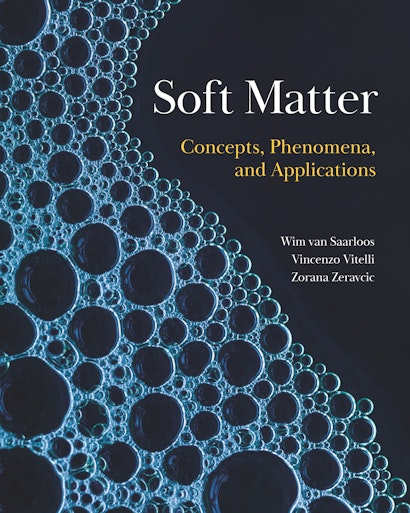Soft Matter: Concepts, Phenomena, and Applications
A comprehensive, modern introduction to soft matter physics


Hardcover
- Sale Price:
- $63.00/£52.50
- Price:
-
$90.00/£75.00 - ISBN:
- Published:
- Dec 19, 2023
- Copyright:
- 2024
- Illus:
- 291 color + 24 b/w illus. 4 tables.
- Main_subject:
- Physics & Astronomy
30% off with code PUP30
ebook
- Sale Price:
- $63.00/£52.50
- Price:
-
$90.00/£75.00 - ISBN:
- Published:
- Dec 19, 2023
- Copyright:
- 2024
- Illus:
- 291 color + 24 b/w illus. 4 tables.
- Main_subject:
- Physics & Astronomy
30% off with code PUP30
Soft matter science is an interdisciplinary field at the interface of physics, biology, chemistry, engineering, and materials science. It encompasses colloids, polymers, and liquid crystals as well as rapidly emerging topics such as metamaterials, memory formation and learning in matter, bioactive systems, and artificial life. This textbook introduces key phenomena and concepts in soft matter from a modern perspective, marrying established knowledge with the latest developments and applications. The presentation integrates statistical mechanics, dynamical systems, and hydrodynamic approaches, emphasizing conservation laws and broken symmetries as guiding principles while paying attention to computational and machine learning advances.
- An all-in-one textbook for advanced undergraduates and graduate students and an invaluable reference for practitioners
- Features introductory chapters on fluid mechanics, elasticity, and stochastic phenomena
- Covers advanced topics such as pattern formation and active matter
- Discusses technological applications as well as relevant phenomena in the life sciences
- Offers perspectives on emerging research directions
- Includes more than a hundred step-by-step problems suitable for active learning and flipped-classroom settings
- Accompanied by a website with additional material such as movies of experimental systems
- Solutions manual (available only to instructors)
List of Figures
Preface
Introduction: The Challenges, Relevance, and Fun of Soft Matter
I.1 Inspiration from an example
I.2 Our view of soft matter and our approach
I.2.1 Our approach in this book
I.2.2 The hydrodynamic perspective
I.2.3 A field relevant to society
I.3 Outline of the book and how to use it
I GROUNDWORK: FROM CLASSIC RESULTS TO SOFT MATTER TODAY
1 Fluid Dynamics
1.1 The relevance and attractiveness of a continuum description of fluids
1.2 Hydrodynamics as a balance equation of fluid elements
1.3 Derivation of the equations
1.3.1 The material or convective derivative
1.3.2 Separating out the various components of flow
1.3.3 Conservation of mass
1.3.4 Conservation of momentum
1.3.5 Conservation of energy
1.4 Once more: Reflections on the underlying picture
1.5 The dissipative terms: Onsager reciprocity relations
1.6 The stress tensor and heat current for a Newtonian fluid
1.6.1 Stress tensor and heat current
1.6.2 The resulting hydrodynamic equations
1.6.3 Heat diffusion equation
1.7 Sound waves
1.7.1 The equation for sound propagation
1.7.2 Analysis of the equation with damping
1.8 When can we treat a flow as incompressible?
1.9 The Navier-Stokes equations
1.10 The dimensions of physical quantities, dimensionless numbers, and similarity
1.10.1 Dimensions of physical quantities
1.10.2 The Reynolds number
1.10.3 Dimensionless numbers and similarity
1.11 From small to large Reynolds numbers
1.11.1 Low Reynolds number hydrodynamics
1.11.2 Intermediate Reynolds numbers
1.11.3 Very large Reynolds numbers
1.12 Lubrication approximation for thin film flow
1.13 Contact angle, coffee stains, and Marangoni flow
1.13.1 Contact angle and wetting
1.13.2 Coffee stains resulting from enhanced evaporation at the rim of a droplet
1.13.3 Marangoni convection
1.14 Bubble oscillations
1.15 Droplets
1.16 What have we learned
1.17 Box 1: Key dimensionless parameters
1.18 Problems
2 Elasticity
2.1 Elasticity: A time honored subject with a twist
2.2 The strain tensor
2.3 The linear stress-strain relation
2.4 The Poisson ratio
2.5 Frequency-dependent generalization of the shear modulus
2.6 A brief foray into elastodynamics
2.6.1 Sound waves in solids: Continuum approach
2.6.2 Dynamical matrices: Microscopic description of elasticity
2.7 Bending is the low-energy deformation of sheets and rods
2.7.1 Scaling with thickness: Dimensional analysis
2.7.2 Analysis of the strain and energy of a bent sheet
2.7.3 Implications
2.8 Static shapes and buckling of rods
2.8.1 Geometrical quantities for small deflections
2.8.2 Buckling of a long rod
2.8.3 The general force and torque balance equations for static rods
2.8.4 Equations in the small deflection approximation
2.9 Auxetics: Metamaterials with negative Poisson ratio
2.10 Packings of particles jammed together: Beyond standard elastic behavior
2.10.1 The jamming phase diagram
2.10.2 Counting argument for frictionless spheres
2.10.3 Scaling of the ratio of elastic constants
2.10.4 Excess of low-frequency modes
2.10.5 The crossover length scale
2.10.6 Jammed packings versus disordered crystals
2.10.7 Toward designer granular matter
2.11 Dislocations and defect-mediated melting
2.12 Topological mechanics
2.12.1 Topological waves
2.12.2 Topological zero-energy modes
2.13 What have we learned
2.14 Box 2: Summary of Landau theory
2.15 Problems
3 Brownian Motion, Thermal Fluctuations, and Diffusion
3.1 A matter of scales and description
3.2 Langevin equation for Brownian motion
3.2.1 Basis of the Langevin equation
3.2.2 The Langevin equation
3.2.3 Mean square variations of velocity and position: Diffusion
3.2.4 The Stokes-Einstein equation for the diffusion coefficient
3.2.5 Cutting corners and what we learn from it
3.3 The Fokker-Planck equation for the probability distribution
3.3.1 The Fokker-Planck equation: Equivalence to a Langevin equation
3.3.2 The Fokker-Planck equation for the velocity of the Brownian particle
3.3.3 The Fokker-Planck equation for the position of a Brownian particle in an external potential
3.3.4 The diffusion equation and its Gaussian solution
3.3.5 Self-similarity and self-similar solutions
3.3.6 The Kramers problem: Fluctuation-driven escape over a barrier
3.4 The master equation
3.5 Size matters for diffusion and dispersion of Brownian particles
3.5.1 Diffusion
3.5.2 Dispersions versus granular media
3.6 Probing fluctuations and taking advantage of them as a probe
3.6.1 Measuring force constants of biomatter experimentally
3.6.2 Directed Brownian motion of molecular motors
3.6.3 Bending modulus or surface tension from shape fluctuation measurements
3.6.4 Thermal fluctuations in a buckling colloidal chain
3.7 Probing soft matter with scattering techniques
3.7.1 Essentials of scattering experiments
3.7.2 Probing small fluctuations in continuum systems with laser light scattering
3.8 What have we learned
3.9 Box 3: Calculating thermal averages
3.10 Problems
II SOFT MATTER PHASES
4 Colloids
4.1 Colloidal dispersions and emulsions
4.1.1 Colloids: Fundamental studies
4.1.2 Colloids: Application perspective
4.2 Colloids as a thermodynamic system with effective interactions
4.2.1 Hard core particles: Model system with entropic interactions
4.2.2 Colloids tend to attract
4.3 Naturally occurring attractive forces between colloids
4.3.1 The Van der Waals attraction
4.3.2 Depletion interaction
4.3.3 Induced attractive interaction due to perturbations of the surrounding medium
4.4 Repulsive forces
4.4.1 Electrostatic stabilization
4.4.2 Steric stabilization by grafting polymers on the surface
4.5 Playing with colloids as model systems
4.5.1 Colloidal aggregates
4.5.2 From spheres, rods, and plates to cubes and beyond
4.5.3 The use of colloidal crystals to make optical bandgap materials
4.5.4 Colloidal glasses
4.5.5 Colloidal motifs as the building blocks of designer matter
4.5.6 Colloids as active matter
4.6 Non-Newtonian rheology of colloidal dispersions
4.6.1 Shear thinning and shear thickening
4.6.2 A temporal transition due to competition between aging and rejuvenation
4.6.3 Comparison with emulsions
4.6.4 Flow of granular media
4.7 What have we learned
4.8 Problems
5 Polymers
5.1 The ever-broadening field of polymer science
5.2 Polymers: Long chain molecules with many accessible conformations
5.3 Ideal chains, excluded volume effects, and the Flory argument
5.3.1 The ideal chain model
5.3.2 Excluded volume interaction and self-avoiding walks
5.3.3 The Flory argument for the excluded volume interaction
5.3.4 Taking stock
5.4 The wormlike chain model for biopolymers
5.4.1 The wormlike chain model and its persistence length
5.4.2 Charge effects on the persistence length
5.4.3 Why excluded volume effects are small
5.4.4 The force-extension curve of the WLC
5.5 Polymers in solution
5.5.1 The dilute regime
5.5.2 From semi-dilute to concentrated solutions
5.5.3 Concentrated solutions
5.6 Polymer brushes
5.7 Flory-Huggins mean-field theory
5.7.1 Flory-Huggins approach
5.7.2 Flory-Huggins as a mean-field theory
5.8 Response of biopolymer networks
5.8.1 Biopolymer networks
5.8.2 The slack or thermal-fluctuation-induced contraction
5.8.3 The stress-strain response of a network
5.8.4 Beyond the simple approximation
5.9 Reptation and the viscosity of polymer melts
5.9.1 The polymer viscosity plays only a limited role in several relevant flow effects
5.9.2 Reptation
5.10 Non-Newtonian rheology of polymer solutions and melts
5.10.1 Importance of polymer stretching effects
5.10.2 The dimensionless Weissenberg number
5.10.3 The Oldroyd-B and upper convected Maxwell model for polymer rheology
5.10.4 Polymer flow instabilities due to hoop stresses
5.11 What have we learned
5.12 Problems
6 Liquid Crystals
6.1 Liquid crystals as mesophases
6.1.1 A bewildering variety of liquid crystal phases
6.1.2 Molecular liquid crystals versus colloidal liquid crystal phases
6.1.3 The power of coarse-graining in the spirit of Landau
6.1.4 The director field n?
6.2 Landau–de Gennes approach to the isotropic-nematic transition
6.3 Frank energy expression for the nematic director field
6.3.1 The Frank free energy
6.3.2 Splay, twist, and bend distortions
6.3.3 Boundary conditions
6.4 Analysis of equilibrium solutions
6.5 Switching the director with a field: The Fréedericksz transition and LCDs
6.5.1 The Fréedericksz transition
6.5.2 Liquid crystal displays
6.6 Topological defects in the director orientation
6.6.1 Defects in the director field
6.6.2 Visualization of defects in thin samples between crossed polarizers
6.6.3 Interaction of defects in two dimensions
6.7 Nematohydrodynamics based on non-equilibrium thermodynamics
6.8 Playing with the molecular shape
6.9 Opportunities and challenges at interfaces with other fields
6.9.1 Biological liquid crystals
6.9.2 Liquid crystals in droplets and other confined geometries
6.9.3 Colloidal liquid crystals and beyond
6.9.4 Mesophases of lipid molecules relevant to pharmaceutics, cosmetics, and food
6.9.5 Epithelial cells die and disappear near +½ defects
6.10 Renormalization group analysis of the defect unbinding transition
6.10.1 Statistical mechanics of a gas of Coulomb charges
6.10.2 The idea behind the RG calculation: Screening
6.10.3 Setting up the RG calculation
6.10.4 How to derive the renormalization group flow relations
6.10.5 Critical scaling
6.11 What have we learned
6.12 Problems
7 Interfaces, Surfaces, and Membranes
7.1 Fluid interfaces
7.2 Helfrich free energy for membranes
7.3 Virus shapes and buckling transitions in spherical shells
7.4 Crumpling of membranes and sheets
7.4.1 A crumpling transition in thermal systems?
7.4.2 Athermal crumpling by compression
7.5 A soft matter realization of the one-dimensional KPZ equation
7.6 What have we learned
7.7 Problems
III ADVANCED TOPICS
8 Pattern Formation out of Equilibrium
8.1 Spontaneous pattern formation resulting from instabilities
8.2 Gearing up for studying patterns in spatially extended systems
8.2.1 The pitchfork bifurcation of dynamical systems
8.2.2 The Swift-Hohenberg model equation
8.2.3 Supercritical versus subcritical transitions
8.3 Inspiration: Rayleigh-Bénard convection and Turing patterns
8.3.1 The Rayleigh-Bénard instability
8.3.2 Turing instabilities
8.4 Three types of linear instabilities
8.5 Amplitude equations for stationary type I instabilities
8.5.1 Inspiration from a simple perturbative calculation for the Swift-Hohenberg equation
8.5.2 Amplitude equation in one dimension for ?q real
8.5.3 Two-dimensional patterns
8.6 Dynamics just above a type II instability
8.7 Amplitude equations for oscillatory type I instabilities
8.7.1 Amplitude equations for one-dimensional traveling waves
8.7.2 Dominant structures: Sources and sinks
8.7.3 What about two and higher dimensions?
8.8 Amplitude equations for type III instabilities
8.9 Taking stock on pattern formation and the amplitude description
8.9.1 Box 4: Summary of insights from amplitude equation approach
8.9.2 Pattern selection?
8.10 Excitable media
8.10.1 The basic mechanism of excitable media
8.10.2 Excitable waves in chemical systems, nerves, and beyond
8.11 What have we learned
8.12 Problems
9 Active Matter
9.1 Hydrodynamic theories of active matter
9.2 Flocking
9.2.1 The Vicsek model
9.2.2 Flocking and the Mermin-Wagner theorem
9.2.3 Toner-Tu theory
9.3 Motility-induced phase separation
9.3.1 Active Brownian particles
9.3.2 The mechanism behind the instability
9.4 Bacterial suspensions
9.5 Active nematics
9.5.1 Active nemato-hydrodynamics
9.5.2 Transition to chaos and topological defects
9.5.3 Self-propulsion of topological defects
9.6 Active solids
9.6.1 Moving and self-propelled solids
9.6.2 Odd elasticity
9.6.3 Odd elastodynamics
9.7 Chiral active fluids
9.7.1 Hydrodynamics of self-spinning particles
9.7.2 Odd viscosity
9.8 Nonreciprocal phase transitions
9.8.1 Chiral phases in nonreciprocal active matter
9.8.2 Nonreciprocal pattern formation: A case study
9.8.3 Exceptional points and parity-breaking bifurcations
9.8.4 Exceptional points-induced instabilities
9.9 Applications to biological problems
9.9.1 Active gels
9.9.2 Active matter effects during morphogenesis
9.9.3 Tissue mechanics and vertex models
9.10 What have we learned
9.11 Problems
IV PERSPECTIVE: NEW FRONTIERS OF SOFT MATTER
10 From Designing Matter to Mimicking Life
10.1 Designer matter
10.1.1 What we mean by designer matter
10.1.2 Basic concepts and definitions
10.1.3 Examples
10.2 Memory formation in matter
10.2.1 Types of memories in matter
10.2.2 Examples
10.3 Artificial intelligence
10.3.1 Types of machine learning
10.3.2 Neural network architectures
10.3.3 Examples
10.4 Artificial life
10.4.1 What do we mean by artificial life?
10.4.2 Additional concepts and glossary
10.4.3 Examples
Appendix: Notation and Symbols Used
Notes
Bibliography
Image Credits
Index
“Soft materials are around us, on us, and indeed are us. Soft Matter provides a broad introduction to a transdisciplinary field that reflects the material it uncovers, simultaneously gentle in approach and rich in scope. The hydrodynamic seaway to a myriad of phases via coarse-grained models using broken symmetry as a guiding principle, and the treatment of spatiotemporal patterns that result, are particular strengths of the book, and both are likely to enthuse many to learn and develop the many living arms of the subject!”—L. Mahadevan, Harvard University
“Considering the breadth of soft matter, this textbook is a daunting accomplishment. It presents the fundamentals of fluids, elasticity, and fluctuations in synchrony with the introduction of the new concepts and phenomena that make soft matter so rich, varied, and exciting. The authors make palpable the thrill of soft-matter research by describing the striking behavior of its many different phases that permeate our environment and covering forefront research topics—from artificial intelligence to artificial life. This ambitious book succeeds on many levels and should be welcomed by all physicists.”—Sidney R. Nagel, University of Chicago
“How should one teach a class on soft matter? This book is the answer to many confronted with this question. Just like soft matter itself, this book is fascinating, thought-stimulating, and conceptually rich. Given the subject’s relevance to today’s societal challenges, any modern physics curriculum should not be missing a class on this subject or the chance to use this book. Its multilayered structure makes it as enjoyable for first-year students as for researchers who have worked for decades in this still youthful field.”—Detlef Lohse, University of Twente
“If you’re a statistical physicist who wants to gain a working knowledge of the whole scope of modern soft condensed matter phenomena, this is the book for you. For each treated form of soft matter, it shows how powerful mathematical laws dictate its many-body behavior. The book includes externally driven cooperative motion as well as distinctive spatial organizations. It gives the minimal mathematical structure from which the many-body laws can be inferred. It also provides special insight into the just-discovered phenomena of topologically dictated motions and nonreciprocal interactions. All this is conveyed in a relaxed, conversational style.”—Thomas A. Witten, author of Structured Fluids
“The insightful discussions presented in the book, with their emphasis on concepts and their coverage of current research, are extremely valuable for understanding why and when to use the various theories. The book does an excellent job of introducing students to the ‘way of thinking’ in soft matter physics.”—Erwin Frey, Ludwig Maximilian University of Munich
“Soft matter is the stuff of which not only our dreams, but our everyday lives are made—and this wonderful book on the topic fulfills a dream of mine. It encompasses the diversity of the field while remaining precise, deep, modern, and attractive. From fundamental concepts to applications, it provides the reader with a solid interdisciplinary background while cultivating the mental agility and sophistication needed to become an elegant physicist.”—Olivier Dauchot, director of the CNRS Gulliver Laboratory in Paris
“This book gives a comprehensive and balanced presentation of soft condensed matter physics, covering the main physical concepts, more classical areas such as colloids and interfaces, and more recent and advanced topics such as active matter and nonequilibrium pattern formation. It will be very useful for graduate students and researchers in related branches of physics, chemistry, and biology as well as in more general fields such as energy and sustainable development.”—Jean-François Joanny, Collège de France


